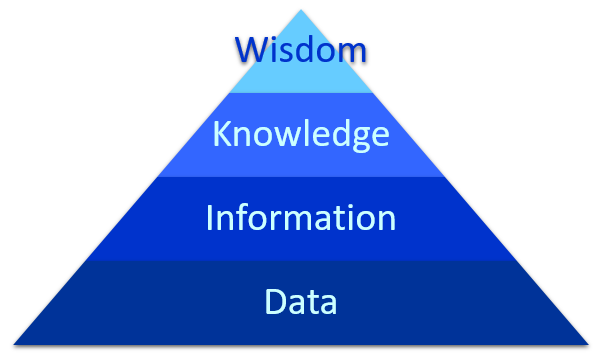The Knowledge Hierarchy
There is a knowledge hierarchy that illustrates how data is transformed into wisdom. This hierarchy of data, information, knowledge, and wisdom (DIKW) is often referred to by various names including the DIKW Hierarchy.
The DIKW hierarchy describes how data evolves into information, knowledge, and wisdom respectively.
D = Data
I = Information
K = Knowledge
W = Wisdom
About the Knowledge Hierarchy
The terms data, information, and knowledge are often used interchangeably. However, these are separate and distinct terms. These terms are better understood if they are shown as a hierarchy of knowledge. The hierarchy describes how the data can be processed and transformed into information, knowledge, and eventually wisdom as it moves up the hierarchy.
Levels of Understanding
From the understanding perspective, the hierarchy can be seen as a process of gathering, researching, absorbing, associating, and reflecting. As the process moves through the stages, the data becomes more meaningful and useful.
A person starts by gathering individual bits of unrelated data which has little value in and of itself. However, a person starts to connect the data parts to form useful information. They then analyze the information to form knowledge, and then eventually take that knowledge and apply it to make wise decisions.
Phases of Time
The hierarchy can also be regarded in terms of time. The first phase involves gathering individual pieces of data, connecting those parts to form information which is given meaning and context to create knowledge, and then it is conceptualize and linked to form wisdom.
DIKW Hierarchy Levels
Data: Unrelated facts and figures
Information: Data enhanced with context and meaning
Knowledge: Information which has been analyzed and interpreted
Wisdom: Ability to use knowledge to reflect and make good decisions
Data
Data is raw facts and figures without relation to other things. It is simply random pieces of information that hold little value or meaning by itself. It is comprised of numbers, symbols, facts, statistics, or random bits of information.
Information
Information is a more complete data set that has been given meaning. It is derived from a collection of processed data where context and meaning have been added to previously unrelated facts by defining relationships and making connections. Information is created by some sort of a relationship between processed data. The creation of information allows for a more thorough analysis.
Knowledge
Knowledge is a collection of information that is useful. It is information that has been refined by analysis where it has been assessed, evaluated, and validated. Knowledge represents a pattern that connects and provides an elevated level of predictability as to what is described or what will happen next. Every piece of knowledge has meanings; however, it cannot generate additional knowledge on its own.
Wisdom
Wisdom is the process of using knowledge to make good decisions. Wisdom allows us to discern between right and wrong, or good and bad. It is the product of reflecting on and extrapolating from the knowledge obtained from information. Wisdom is formed when knowledge is analyzed then implemented in life.


